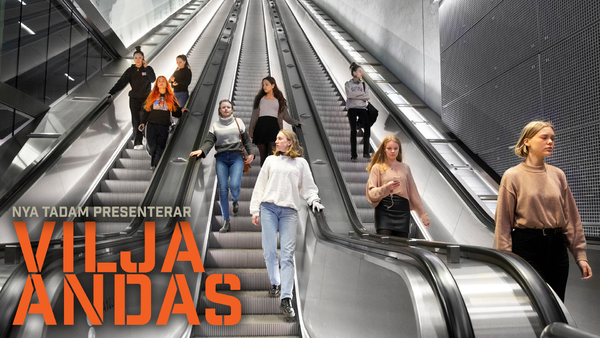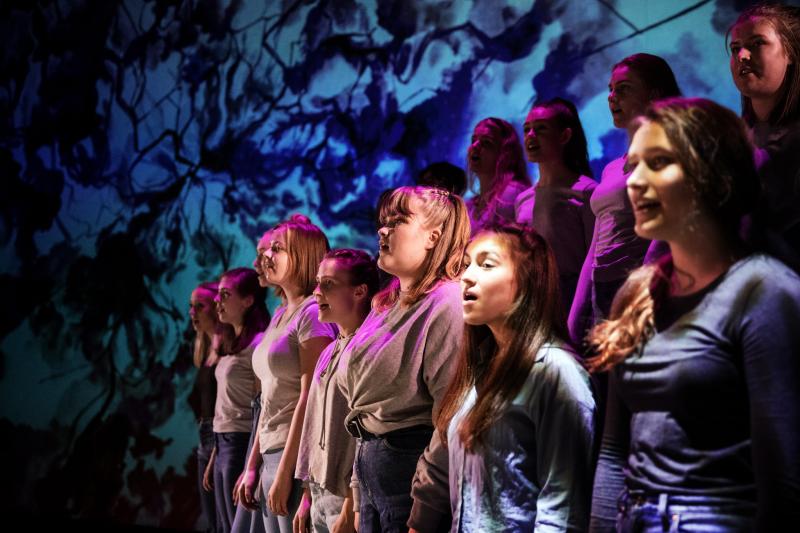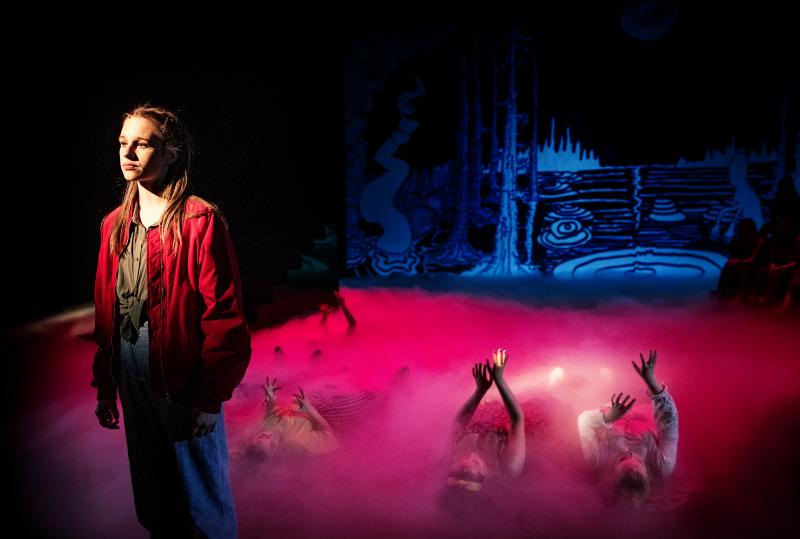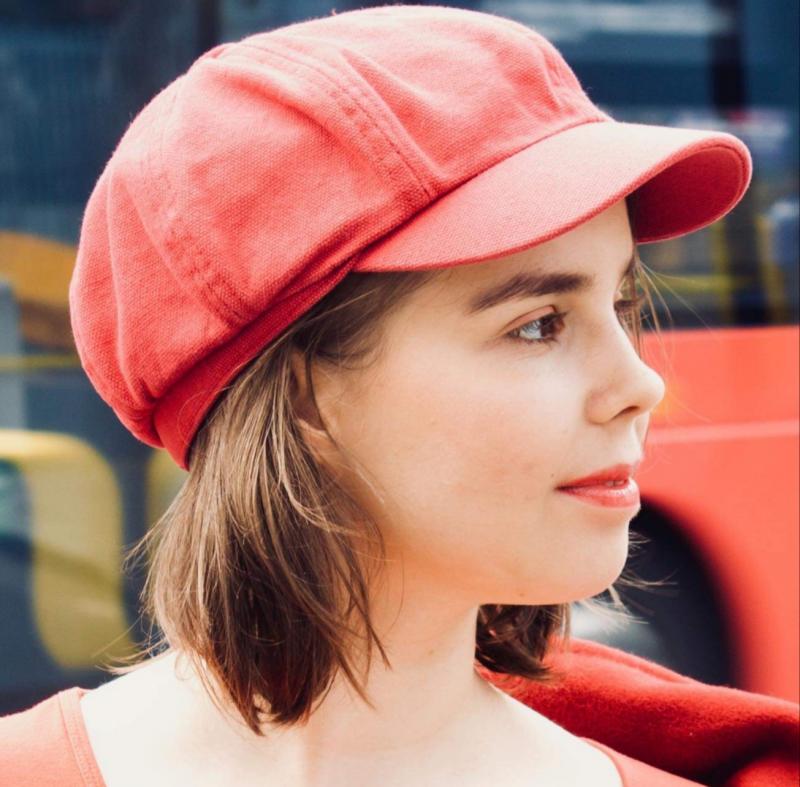Review and Photos: VILJA ANDAS at The Swedish Theatre Of Helsinki

On 22nd of May I went to see the exceptionally stylishly promoted and photographed (see the picture above) Vilja Andas, translated: a will to breathe/Breathe, Vilja at the Swedish theatre of Helsinki. With me there were many youngsters who probably were at a school trip, sitting there at the fine theatre, the time being 12 am.
The show was in Swedish without Finnish subtitles. Luckily I understood the most of the dialog, for I've taken my Swedish classes during my own school years. Nevertheless, even more I focused on the various performatic expressions the young folk (from age 15 to 22) at the musictheatre school of the Swedish theatre were to give.
"The school year is about to end and Vilja (which as a verb means "a will to do something" in Swedish, but is a girl's forename as well, so that's smart) is 18. She has the world at her feet. A world where how you present yourself means the most. A world where's the most important thing is to give an image of yourself that everything's fine and good. Vilja stands at crossroads, but she cannot choose, she just wants to breathe."
The beginning moments of the show are very touching: lights dimmed, sweet music-- and sounds of sobbing. A drawing is projected at the background. It resembles as if a videogame character: an action girl, who stands, her back against us, about to jump off a pinkish cliff that's against a dark and gloomy background. Soon the lights turn slowly on and our main character Vilja (Wilanda Verdecia) stands on a two meter high platform, looking down through her tears. All the other characters, look at her.
A rough start to say the least. The sound of crying itself was brave and a fitting start, but the presentation of the willingness to die and stand at the edge was a little off in my opinion; for we don't know Vilja yet and haven't been given time to sympathize with her. Even a small, one minute beginning where we would have seen her on stage starting to sob and then taking the steps to the platform perhaps would have worked even better and would have given us the time to get to know and get to sync with her as a character.
Now, one actor ceases the scene. She starts telling, looking at us, the audience, how it cannot be like this: we hear newspaper headlines from the performers that tell about the alarming mental state of the youth of Finland:
"Right now there are young people who don't see a hope in their future", we hear a headline and the choir starts to sing.
The scene becomes a song and we also see some well thought-out and good choreography, which symbolises depression and anxiety: they main performers are in a row, their sides towards us before they start falling behind their friends at their backs like dominos, then completely falling down, slowly.
I think the first few minutes set the ground to any show: what is it going to be like, are we going to see a story with big expressions, with an informative text or what. By these first minutes at Vilja Andas I got the image that this show is going to be based on a informative, clearly laid out text and dialogue but also some danceful elements, topped up with skillful live music and singing. But then later on, at least to my eye, the dancing or choreographical elements were nonexistent in many scenes where there could have been some to rhythm the scene. For example in the scene where a bunch of girls queued for the curator's office; there they could have had some small, synced and symbolic movement to tell the story through danceful elements, at the background of the dialog between Vilja and the curator. The main stage of the theatre itself is so huge that it could have been benefited from more effectively. So in a choreographical sense, I think this version would have suited better on a smaller stage.
Nevertheless, Vilja Andas is a clear show that speaks facts through a straight contact with the audience more strongly than it shows them in an imaginative, theatrical ways: so it is very approachable to everyone. The choir at the back comments the decisions of Vilja and others as if a group of some-followers. The drawings by the Töölö high school's students of art, which are projected at the back are very impacting, though through the end's flower drawing I got a need that there could have been some other type of drawings behind the neutral scenes too, like in the change of Vilja scenes there were the fish. Vilja's change scenes were very beautiful every time, choreographically, musically and by the terms of the story telling.

In the musical part with the "You have to train" there was some good focus and energy from the performers that I would have wanted to see more. Also the transition from the scene where Vilja faintly tells how it would be nice to talk to someone, somebody comes to interrupt it by shouting: partyyy! And so the scene moves into a party, where the doing and a gleeful presence of the young actors was good all along.
Vilja's red jacket was a good idea and would have worked even better if all the main characters' costume design would have been more unified, or even just by switching all the long sleeves that distracted from the effect of the red jacket to t-shirts. Small details make the big picture!
The scenic image with the 15-year-old Vilja and the red smoke was truly remarkable!

I didn't like the scenes where our performer stood still and sung, looking straight into the audience either alone or in a group: it is a good effect, not moving at all, if done only once, but in this show's case there were far too many of them in my opinion to stand out in terms of storytelling's effects.
The best parts in terms of acting were delivered in the scenes where the spotlight hit our performers as Vilja, one scene after another, and so the actors were given time and space to focus on their parts of delivering an emotional monologue.
I also loved both of the curators: the first one was a spot on character that fit perfectly to the habitus of the performer Catarina Korkman. The second, played by Christa Lundström, her head turn was very well timed and built into the scene where Vilja tries to utter out her thoughts. It was one of the best parts of the show, because it was so accurate.
The team of Vilja Andas are delivering an important message, there's no doubt about it.
The ending scene where the characters jump off the platform to the saving hands of the other characters is so symbolic and strong scenic image that the smiling reactions after the catching makes it a little kornish.
All in all Vilja Andas is an informative performance that speaks on important topics, for example how ill must someone be mentally before they are valid to get help? The music fits well to the way of the storytelling. The songs are highly enjoyable and the scenes are touching at their best. Even though I noticed some parts that could have needed a little more polishing and choreographical adds or either focusing the storytelling differently, in spite of them Vilja Andas is a fairly good show by the youth of the musictheatre school of the Swedish Theatre of Helsinki, Nya Tadam.

Article: Rosanna Liuski
Photos: Cata Portin
ON STAGEFelicia Karrenberg, Catarina Korkman, Sofia Lax, Christa Lundström, Saana Pihlatie, Wilanda Verdecia, Ingrid Väyrynen, Ilmi-Emmi Wentzel, Livia Wikström KUORO BAND PRODUCTION |
|
Reader Reviews

Videos

